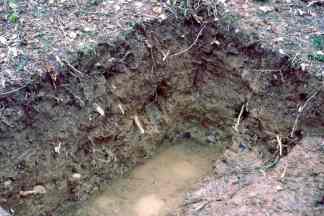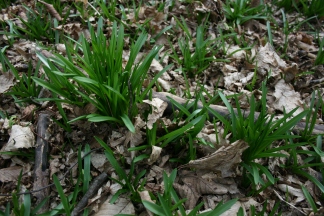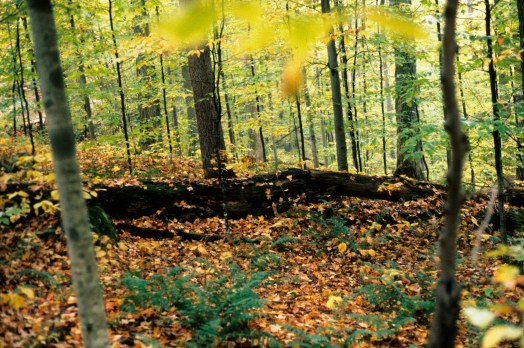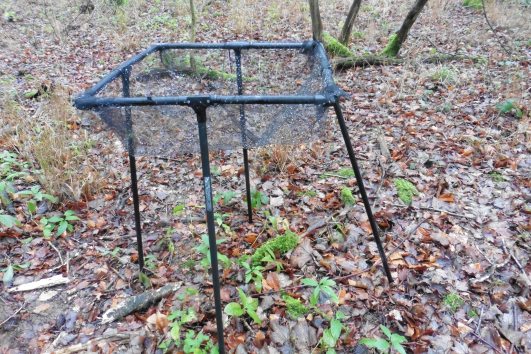We were up in the woods last week and the beech leaves were a beautiful golden in the autumn light. The fluttering as they fell added to the atmosphere, but apart from lending magic to dull November days, litter plays a bigger role in the life of a wood than often we give it credit.
Live green leaves are full of the important mineral nutrients needed to keep the photosynthesis show on the road, but as they start to die some of these are withdrawn back into the tree. What’s left will get released into the soil as the leaves are broken down on or in the ground. The rate at which the leaves decay thus is critical to nutrient cycling within the wood. Elm, alder and particularly ash leaves tend to break down rapidly; most have gone by the following summer, so there is bare soil visible. Other tree leaves such as those of sycamore and lime may take two years to disappear; oak and beech three years; and some of the conifers even longer (Ellenberg, 1988).
Bags of leaf litter being used to explore decomposition rates; Beech litter in Wytham Woods in the middle of summer.
On soils with a neutral to high pH there are usually plenty of earthworms and much of the litter may be dragged down into the soil. The carbon gets incorporated throughout the upper layers, forming brown earths. By contrast, slowly decomposing leaves on acid soils where earthworms are scarce, accumulate as thick litter layers on the top of the soil. Such accumulations of litter affect the ground flora patterns. Small seedlings growing on the top of thick litter may find it difficult to get their roots down into the moist lower layers, and so die-off. Shoots growing up from bulbs litter have to be able to push through the litter layers in spring, sometimes spearing the leaves: not all species can do this (Sydes and Grime, 1981).


Soil pit showing only thin litter layer and incorporation of carbon down the profile; bluebells spearing through the litter in spring.
We tend to think of earthworms therefore as ‘a good thing’ because they reduce the litter layers and increase soil carbon. However, this may not be true everywhere. North American forests lacked the deep-burrowing earthworms, or rather they did, until they were introduced for example as fishing bait. Invasive worms now break down the deep litter layers that were part of the American hardwood forests, leaving the upper roots exposed and reducing understorey diversity (Hale et al., 2006).

An American mixed hardwood stand with deep litter.
Litter was also a valuable resource in past, that was collected for animal bedding (Bürgi and Gimmi, 2007), particularly where the livestock was kept in stalls. The leaves absorbed the urine and could then be spread on to arable fields as manure. This was still being practised in the Canary Islands in the 1980s. There is less evidence for this in Britain but in the Blean Woods in Kent, Dave Maylam once told me that new coppiced areas might almost be swept clean. Removing the litter from the woods could lead to nutrient depletion of the soil; so we might expect soils to become more eutrophic after litter collection stopped. There is some evidence from a Polish study that this does indeed happen (Dzwonko and Gawroński, 2002).
Part of an experiment where litter has been removed from one part of the woods and added to plots elsewhere to double the amount for decomposition.
Further changes to the litter regimes in woods will come about through climate change. Litter production may go up because trees grow more in warmer conditions with higher carbon dioxide levels (assuming the trees are not drought limited), but so may litter breakdown rates. If breakdown speeds up more than the increased addition of litter, then more of the long-term soil carbon store may be released into the atmosphere adding to the greenhouse gas effects.
We do need therefore to keep an eye on woodland litter and what is happening to it.

Litter trap.
BÜRGI, M. & GIMMI, U. 2007. Three objectives of historical ecology: the case of litter collecting in Central European forests. Landscape Ecology, 22, 77-87.
DZWONKO, Z. & GAWROŃSKI, S. 2002. Effect of litter removal on species richness and acidification of a mixed oak-pine woodland. Biological Conservation, 106, 389-398.
ELLENBERG, H. 1988. The vegetation ecology of central Europe., Cambridge, Cambridge University Press.
HALE, C. M., FRELICH, L. E. & REICH, P. B. 2006. CHANGES IN HARDWOOD FOREST UNDERSTORY PLANT COMMUNITIES IN RESPONSE TO EUROPEAN EARTHWORM INVASIONS. Ecology, 87, 1637-1649.
SYDES, C. & GRIME, J. P. 1981. Effects of Tree Leaf Litter on Herbaceous Vegetation in Deciduous Woodland: I. Field Investigations. Journal of Ecology, 69, 237-248.





i didn’t know that about earthworms! Will tweet
LikeLike